Abstract
The purpose of this work was to consolidate the eco-friendly Al–SiC composites prepared with various weight fractions of ceramic particles (0; 2.5; 5; 10; 15 wt.% SiC) in the energy-saving sintering process under vacuum and in a nitrogen atmosphere at 600 °C. The density of the manufactured composites was determined using Archimedes’ method. The mechanical properties and strength characteristics of the metal–ceramic interface were measured using three-point flexural and uniaxial compression tests, as well as the Brinell hardness measurement. The tribological properties were evaluated by determining the coefficients of friction and weight losses of the tested materials and identifying the tribological wear mechanisms. Advanced microstructural observation methods, such as scanning electron microscopy (SEM) and transmission electron microscopy (TEM), were used to analyze the microstructure of the composites in detail, including the identification of the phase composition using X-ray analysis methods. Low-cost composites with a porosity not exceeding 7% were successfully produced via energy-saving production routes. Simultaneously, owing to the formation of aluminum nitrides during sintering in a nitrogen atmosphere, these composites exhibited mechanical and tribological properties superior to those of materials sintered under vacuum.
1. Introduction
Eco-friendly composite materials are the response to the great demand to reduce the weight of elements, resulting from global restrictions to reduce fuel and energy consumption as well as CO2 emissions [1,2]. The green composite industry is looking for sustainability in the production processes of environmentally friendly composite materials possessing a high strength-to-low density ratio and energy efficiency [3,4,5]. One of the basic materials used in construction, the automotive industry, and the production of electrical devices is steel. Nevertheless, as the steel production process occurs at elevated temperatures, it consumes a substantial amount of energy and emits pollutants, including CO2. One of the main environmental problems is global warming, which is caused by CO2 emissions. Therefore, solutions are being sought in the form of environmentally sustainable alternative materials to steel. Metal matrix composites provide an eco-friendly and cost-effective alternative to steel elements [6]. The metal–ceramic combination enables the formation of structures with improved stiffness and structural integrity and that successfully replace metals and their alloys [7]. Ceramic-reinforced metal matrix composites are characterized by high strength, low density, and good thermal conductivity [8]. The strong bond between the aluminum matrix and the reinforcing phase determines the mechanical properties of these composites because interfacial bonding takes place in the load-bearing process [9].
Although the production cost of metal matrix composites is reported to be higher than that of steel [10,11,12], the advantages of aluminum matrix composites, such as lighter weights, durabilities, and corrosion resistances, contribute to extended component lifespans [12]. The chosen manufacturing method, whether for steel or aluminum matrix composites, influences the embodied energy (EE), which is the total energy needed to produce the final product [6]. Studies indicate that aluminum matrix composites generally exhibit lower EEs than steel, offering energy savings in production processes [13]. Amirtharaj et al. [6] observed that aluminum matrix composites exhibit lower energy efficiencies (EEs) compared to steel. The production of steel demands a substantial amount of energy and resources. In contrast, the manufacturing of metal composites through solid-state powder metallurgy processes involving blending, pressing, and sintering proves to be more energy efficient. This directly leads to reduced production costs, as lower temperatures are utilized compared to those of the metallurgical processes [14,15]. Powder metallurgy ensures a high level of process control, contributing to dimensional accuracy and eliminating the need for post-processing. Consequently, this approach minimizes the material waste [16,17].
Metal matrix composites, based on light metals, have garnered increasing attention owing to their enhanced properties, which are facilitated by the metal–ceramic interface. This makes them promising materials for application in the aviation, automotive (especially in the realm of green vehicles), and electronics industries [18]. The widespread use of Al-based composites reinforced with ceramic particles in combustion engine components, brake discs, and drive shafts is attributed to their high specific strengths and resistances to abrasive wear, coupled with a reduction in weight [19]. Weight reduction is crucial in the automotive industry for enhancing energy savings [20]. Al–SiC composites, for instance, find applications in brake discs and drums in the automotive sector owing to the low density of aluminum. The utilization of these composites enables a significant reduction in element weight while maintaining high resistance to abrasive wear. Wojciechowski et al. [21] reported that the adoption of Al–SiC composites for brake discs by DURALCAN led to a 50% reduction in weight compared to traditionally used cast iron discs and a three-fold increase in heat exchange efficiency. This weight reduction translates to substantial cost savings, primarily because it contributes to the overall vehicle weight reduction, thereby improving the fuel efficiency and reducing pollutant emissions into the atmosphere. Knorr-Bremse AG serves as an example, achieving an almost 40% weight reduction by replacing cast iron brake discs with Al–SiC discs in trains. Other notable manufacturers utilizing Al–SiC composites for drums and brake discs include Lotus, Chrysler, and Ford (Taurus). The growing recognition of resource depletion and the imperative for judicious resource utilization underscore the need for active engagement by the global metal recycling industry. This involvement is particularly vital in the recovery of non-ferrous metals from waste sources [22,23]. Hence, another notable advantage for utilizing aluminum is its recyclability. Aluminum can be reclaimed from machining and manufacturing processes, often in the form of chips and scraps, and then repurposed as the matrix material for composites [24]. This closed-loop approach not only promotes sustainable practices but also contributes to the conservation of valuable resources.
Numerous studies have noted an improvement in hardness with the addition of SiC to the aluminum matrix [25,26,27]. For instance, the literature reports that incorporating 10 wt.% SiC into the AA2124 alloy matrix increased the Young’s modulus from 72 to 81 GPa [28]. Similar observations were made by Cai et al., achieving a Young’s modulus increase of approximately 21 GPa with 55% SiC addition to the aluminum matrix [29]. Rutecka et al. obtained a Young’s modulus value of 110 GPa for the AA2124 matrix composite reinforced with 25% SiC [30]. Kumar et al. [31] investigated the effect of the weight fraction of SiC on the mechanical and tribological properties of Al-5.6Zn-2.2Mg-1.3Cu matrix composites. The authors observed a decrease in the wear rate as the weight fraction of SiC increased. Shaikh et al. [32] investigated the influences of the sintering method on the mechanical and tribological properties of Al–SiC composites with low contents of SiC (1; 3; 5 wt.%). Their findings indicated improvements in the hardness and wear resistance following the addition of the ceramic particles. Pradhan et al. [33] reported positive effects on the abrasion resistance upon adding SiC to Al–SiC composites in their research.
The incorporation of a hard SiC reinforcing phase into the aluminum matrix stands out as a pivotal strategy for significantly enhancing the abrasive wear resistance. This improvement is notably proportional to the escalating content of the reinforcing phase [34,35,36]. In the realm of aluminum composites, the correlation between the abrasive wear resistance and hardness becomes evident with studies such as [37], where an augmentation in both properties was observed by elevating the volume fraction of the SiC phase from 4 to 10%. Further investigations, as reported in [38], highlight a direct relationship between the hardness and the weight fraction of the SiC phase. An increase from 10 to 20% resulted in a noticeable rise in the hardness from 34 to 40 HB. However, the delicate balance becomes apparent in [39], where a decrease in hardness was noted upon surpassing 20% of the SiC reinforcing-phase content. This underscores the critical role played by the percentage of the reinforcement in determining the ultimate properties of the composite. For composites intended for structural and abrasive applications, maintaining the volume fraction of the reinforcement below 30% is a common practice. This precaution is rooted in the understanding that an excessively high SiC particle content could render the composite as brittle. The delicate interplay between the reinforcement content and composite integrity is crucial for achieving the optimal performance. The mechanical and tribological characteristics of aluminum-based composites are intricately linked to the resultant microstructure post the introduction of ceramic particles to the reinforcing phase. The evolution of this microstructure is contingent on the chosen manufacturing technique and the composite’s composition. Despite the general trend of heightened tensile strength in composites with added reinforcements, the findings in [40] introduce a nuanced perspective. A composite featuring an aluminum matrix reinforced by 10 wt.% SiC exhibited a decrease in strength. This anomalous behavior is attributed to the segregation of SiC particles, emphasizing the paramount importance for achieving an even distribution of silicon carbide within the matrix.
In this study, we explored Al–SiC composites owing to their unique properties arising from the combination of a low-density plastic matrix and the hardness of the ceramic particles in the reinforcement phase. The literature is, indeed, replete with studies on the production of Al–SiC composites. However, our conducted research sought to go beyond the existing body of work by specifically evaluating the influences of various parameters within the manufacturing process—specifically, the sintering atmosphere—on the microstructural, mechanical, and tribological properties of Al–SiC composite materials. Although previous research has delved into the fundamental aspects of composite production, our focus on manipulating the sintering atmosphere represents a novel approach. This deliberate exploration aims to unravel the nuanced effects of atmospheric conditions during the sintering phase on the resulting materials’ characteristics. Challenges in the fabrication process, such as achieving a uniform dispersion of silicon carbide particles and preventing the formation of undesirable phases resulting from reactions between sintered materials and elements in the atmosphere, as well as the presence of oxides in sintered materials with a high affinity for oxygen still require attention. Researchers are continuously working on optimizing the manufacturing processes to enhance the performance and reliability of Al–SiC composites. Within the extensive array of materials, a notable gap exists in research that permits a comprehensive characterization of tribological wear mechanisms. Existing studies outlined in the literature predominantly center on illustrating the correlation between the coefficient of friction and weight loss concerning the strengthening-phase content. The novelty of our research lies in delving deeper into this area, aiming to bridge the existing gap. The outcomes of our microstructural observations on surfaces following friction will furnish valuable insights into the operational wear mechanisms. Importantly, these findings will enable the establishment of meaningful connections between wear mechanisms and the dynamics of friction. This correlation will be explored in relation to the chemical composition of the sintering atmosphere and the content of the SiC-phase particles within the composite. By addressing this research gap, our work aspires to contribute significantly to the understanding of the tribological behavior in a diverse range of materials.
The adoption of an energy-saving sintering process both under vacuum and in a nitrogen atmosphere at 600 °C stands out as a significant contribution. This not only enhances resource efficiency but also introduces a novel approach to the manufacturing process, potentially reducing the environmental impact of composite production. A crucial consideration in the material production process is its economic aspect. The pursuit of cost-effective and environmentally neutral solutions remains paramount, with low product costs being an indispensable criterion in the technological process. To address cost concerns, our research employed conventional powder metallurgy techniques involving simple mixing, pressing, and sintering while utilizing a relatively low sintering temperature for the fabrication of Al–SiC composites. Additionally, we investigated the impacts of these methods on the mechanical and tribological properties of the resulting composites.
In summary, the novelty of this work lies in its holistic approach, which integrates eco-friendliness, the exploration of variable compositions, energy-saving processes, the influences of nitrogen and vacuum atmospheres, cost-effective production, and comprehensive characterization techniques. These findings make substantial contributions to both the theoretical understanding and the practical applications of Al–SiC composites.
2. Materials and Methods
Aluminum recycled from scrap was melted and argon atomized to obtain Al powder for the matrix material. As a reinforcement material, the synthetized SiC particles were applied at different weight fractions of 2.5, 5, 7.5, 10, and 15 wt.% to the matrix. The morphologies of the starting powders are presented in Figure 1. The particle size of the aluminum powder was less than 63 µm, while the particle size of the reinforcement phase was in the range 60–80 µm. In the first stage of the composite production, the elementary Al and SiC powders were mixed in a Turbula T2F mixer (WAB, Muttenz, Switzerland) for 30 min to obtain homogeneous composite mixtures. The powder mixtures were consolidated in a rigid die, using a single-action compaction press at a pressure of 300 MPa on a hydraulic press. The consolidated green bodies had cuboid shapes with dimensions of 4.5 × 5 × 40 mm. No lubricants were applied during the cold-compaction process. A crucial stage in forming composites through conventional powder metallurgy technology is sintering, which significantly impacts both the microstructure and the final physical and mechanical properties of the resulting materials. The parameters of the sintering process play a vital role in shaping new phases through reactions between the matrix and atmospheric gases, thereby influencing the microstructural changes. The conducted research aimed to elucidate the impacts of different sintering atmospheres (nitrogen and vacuum) on the microstructural, mechanical, and tribological properties of the Al–SiC composites. The sintering process of the green bodies occurred at a temperature of 600 °C for 1 h. The furnace took approximately 20 min to reach the sintering temperature of 600 °C (at a rate of about 30 °C/min), with the samples being heated within the furnace. Subsequently, the cooling process, conducted in the furnace cooler, took 10 min to return to the ambient temperature (at a rate of about 60 °C/min). To reduce the porosity, the sinters underwent a process of re-pressing and re-sintering with the same compaction and sintering parameters.

Figure 1.
The SEM morphologies of the initial powders: (a) Al; (b) SiC.
The densities of the produced composite materials were determined based on Archimedes’ principle. The masses were determined to an accuracy of 0.0001 g. One of the stages of the investigation was the assessment of the mechanical properties of the obtained composites. These properties were determined by measuring the Brinell hardness, performing a compression test, and determining the flexural strength in a three-point flexural test. The static uniaxial compression test and the three-point flexural test were performed at the ambient temperature on a Zwick Roell Z020 test machine (Zwick Roell, Ulm, Germany) in accordance with the ASTM E-9–89a [41] and ASTM E290-22 [42] standards, respectively. The compression test was performed at an initial strain rate of 8·10−3s−1 and was interrupted after reaching a permanent deformation of 45%. The flexural test was carried out at a constant tool-feed speed of 0.05 mm/s, and the measurement base was 28 mm. Hardness tests were conducted following the ASTM E10-18 [43] standard, employing the Brinell method. A sintered carbide ball indenter with a diameter of 2.5 mm and a force of 306.5 N was utilized. Density, hardness, and flexural and compressive strength measurements were performed in three tests for each compositional variant and sintering parameter. For hardness measurements, three readings were taken on two opposing sides of each sample, and the reported values represent the averages.
The wear resistances of the Al–SiC composites were tested on a block on a ring T-05 tribotester (Łukasiewicz, ITeE, Radom, Poland) at the ambient temperature under dry friction conditions according to the ASTM D 2714-94 standard [44]. The tests were carried out on cuboidal samples with dimensions of 20 × 4 × 4 mm. The tests used a counter sample (rotary ring) with a diameter of 49.5 mm and made of heat-treated 100Cr6 steel with a hardness of 55 HRC. All the measurements were carried out under technically dry friction conditions at a constant ring rotation speed of 136 rpm. During the tests, a constant load of 50 N was applied, and the sliding distance was equal to 500 m.
The microstructures of the sinters were observed using a HITACHI SU 70 Schottky-type electron gun scanning electron microscope (SEM) (Hitachi, Tokyo, Japan) with a Thermo Scientific NORAN System 7 X-ray microanalysis system (EDS) (Thermo Fisher Scientific, Waltham, MA, USA). Additionally, microstructural studies were carried out using a JEOL JEM 2010 ARP transmission electron microscope (JEOL Ltd., Tokyo, Japan). The described electron microscopy observation techniques were used for the detailed analysis of the microstructures of the composites. The chemical compositions in micro-areas were also examined using the EDS method. A scanning electron microscope was also used to observe fractures after the three-point flexural tests and surfaces after the tribological tests. Phase composition tests were carried out using a D8 Advance X-ray diffractometer (Bruker, Karlsruhe, Germany) with Co Kα = 1.79 Å. The data were compiled using the diffraction database (powder diffraction file) developed and published by the ICDD (International Centre for Diffraction Data).
3. Results
3.1. Archimedes’ Densities
The relative densities, correlated with the chemical compositions of the obtained materials, were categorized into series according to the sintering atmosphere (Figure 2). Irrespective of the sintering atmosphere or the weight fraction of the reinforcement particles, the relative densities of the composites consistently surpassed 92% of the theoretical densities. The aluminum matrix of the composites exhibited the highest density. The relative density of aluminum is 97.81% of the theoretical density after sintering in a nitrogen atmosphere and 95.21% after sintering in a vacuum atmosphere. The introduction of a hard ceramic phase hinders the densification process, constraining the mass transport during sintering and resulting in a reduction in the relative densities of the Al–SiC composites [45]. Although the relative densities of the sinters decreased with a rise in the reinforcement phase content, an advantageous impact of the nitrogen atmosphere became evident in the sintering process of the Al–SiC composites. The use of nitrogen facilitated the enhanced densification of the composite materials compared with those sintered in a vacuum atmosphere. However, this positive effect of the nitrogen sintering atmosphere over the vacuum atmosphere on the degree of densification diminishes as the composition shifts toward higher SiC contents.
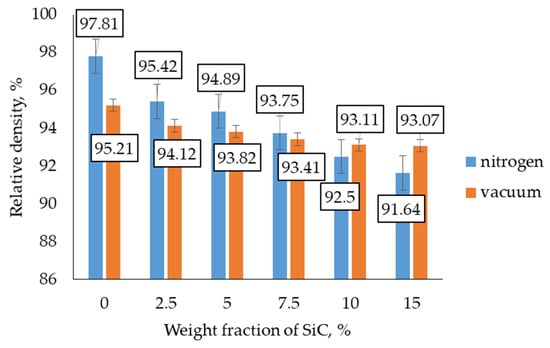
Figure 2.
Variation in Archimedes’ densities of sintered aluminum matrix and Al–SiC composites, depending on the weight fraction of the reinforcement and the sintering atmosphere.
3.2. Microstructures
Figure 3 and Figure 4 show the characteristic images of the microstructures of the aluminum matrix and Al–SiC composites, respectively, as taken using a scanning electron microscope. The microstructure of the matrix material sintered in a nitrogen atmosphere (one of the cheapest atmospheres) consists mostly of regular aluminum grains and a few pores located at the grain boundaries. In both the matrix and composites sintered under vacuum, spherical-shaped aluminum grains are visible, suggesting a less effective consolidation of powders compared with those sintered in a nitrogen atmosphere. Locally, visible pores near the boundaries further indicate suboptimal consolidation. The introduction of SiC powder particles, similar in size to the matrix particles, allowed for the uniform distribution of the reinforcement phase in the matrix, regardless of the sintering atmosphere that was applied. Observations revealed cracks in individual SiC particles, propagating into the matrix material and leading to discontinuities and micro-cracks within the matrix. Coarse-grained particles, owing to potential defects like cracks or voids, may be more susceptible to cracking under external stress. The reinforcement phase, with such defects, might not effectively transfer external loads, becoming a potential area for crack initiation and propagation and consequently impacting the mechanical properties. In the vacuum-sintered composites, micro-pores are visible at the reinforcement–matrix interface, a phenomenon absent in the composites sintered in a nitrogen atmosphere.
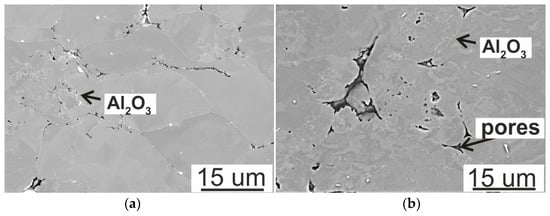
Figure 3.
SEM microstructures of aluminum matrix sintered (a) in nitrogen atmosphere; (b) under vacuum.
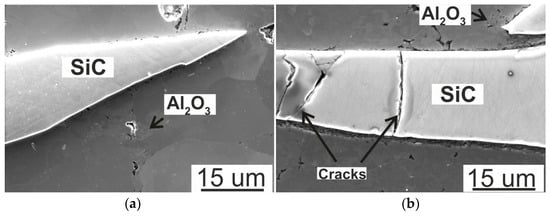
Figure 4.
SEM microstructures of aluminum matrix composite with the addition of 5 wt.% SiC and sintered (a) in nitrogen atmosphere; (b) under vacuum.
In both the microstructures of the matrix material and the tested composites, a network of fine Al2O3 oxides was observed at grain boundaries, the aluminum–silicon carbide interface, and areas with increased porosity. This observation was confirmed through an elemental analysis conducted in micro-areas using an EDS detector, as performed for the composite with the addition of 7.5 wt.% SiC and sintered under vacuum (Figure 5). Additionally, after the composite was sintered in a nitrogen atmosphere, the element distribution maps for the aluminum matrix confirmed the presence of aluminum nitrides (Figure 6). AlN predominantly appeared in areas with increased porosity, where open pores allowed nitrogen inflow from the sintering atmosphere. Owing to their strong affinity for oxygen, aluminum particles were enveloped in a thin layer of aluminum oxide, forming a continuous film. This oxide layer acts as a barrier to proper bonding between individual components, potentially influencing the final material properties. On the positive side, finely dispersed Al2O3 particles may enhance material properties by serving as an additional reinforcement phase. During pressing, the oxide coating on the surface of the aluminum powder particles may crack, increasing the adhesion force between individual aluminum particles and facilitating the formation of strong intermetallic bonds. The aluminum oxide layer covering the aluminum powder particles is typically amorphous and thermodynamically unstable. It easily transforms into a crystalline form during the sintering process, interrupting the continuity of the oxide film. This exposure of active metal surfaces enables direct contact between the aluminum and the sintering atmosphere. The disruption of the oxide layer during heating is also influenced by the residual stresses generated by the significant difference between the thermal expansion coefficients of the pure aluminum (2.39 × 10−5 K−1) and γ-Al2O3 oxide (2.61 × 10−6 K−1) [46].
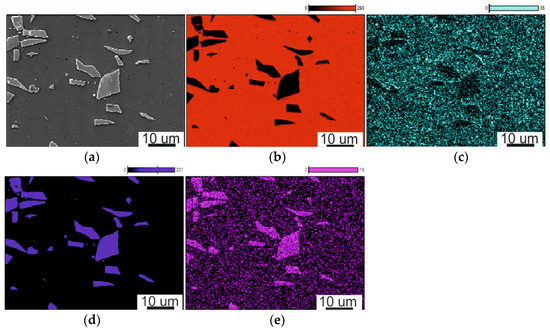
Figure 5.
(a) SEM micrograph of aluminum matrix composite with the addition of 7.5 wt.% SiC and sintered under vacuum and the corresponding EDS mapping micrographs of (b) Al; (c) O; (d) Si; (e) C.

Figure 6.
(a) SEM micrograph of aluminum matrix composite sintered in nitrogen and the corresponding EDS mapping micrographs of (b) N; (c) O.
In the nitrogen-sintered Al–SiC composites, nitrogen can reduce aluminum oxide and form aluminum nitrides. Sintering aluminum and its alloys in a nitrogen atmosphere provides an advantage in the formation of aluminum nitrides, acting as an additional strengthening factor in Al–SiC composites. The formation of aluminum nitrides involves highly exothermic reactions, initiated by the presence of nitrogen in direct contact with freshly exposed aluminum surfaces. The energy required for breaking the strong triple bonds in the nitrogen molecule is sourced from the energy released during repeated exothermic allotropic transformations of the aluminum oxide [47]. The presence of aluminum nitrides in the aluminum sintered in a nitrogen atmosphere was confirmed by X-ray diffractograms (Figure 7). Figure 7a shows the XRD pattern of the Al matrix sintered in a nitrogen atmosphere, accompanied by a magnified view (Figure 7b) for a better visualization of the phases included in the matrix. Similarly, Figure 8a presents the X-ray pattern for the Al matrix sintered under vacuum, along with the pattern’s magnification (Figure 8b). The TEM images (Figure 9) captured for the aluminum matrix sintered in nitrogen and under vacuum reveal the presence of aluminum nitrides, which form in materials sintered in a nitrogen atmosphere, inhibiting the grain growth (Figure 9a), and the presence of aluminum oxides (Figure 9b).
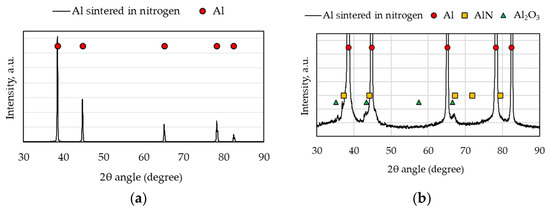
Figure 7.
(a) XRD pattern of the aluminum matrix sintered in nitrogen; (b) magnified XRD pattern.
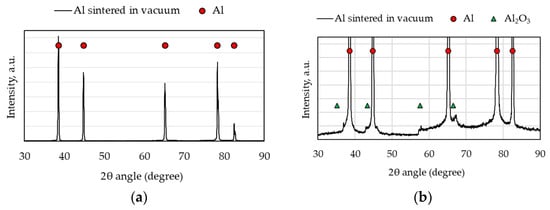
Figure 8.
(a) XRD pattern of the aluminum matrix sintered under vacuum; (b) magnified XRD pattern.
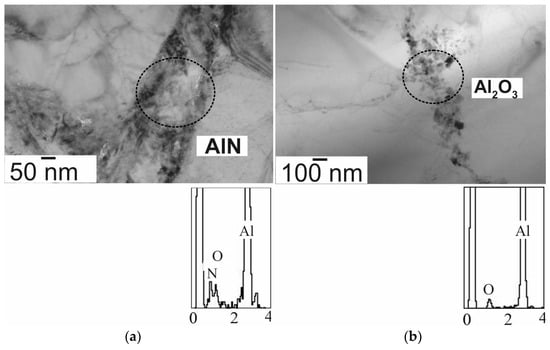
Figure 9.
TEM images of aluminum matrix sintered (a) in nitrogen; (b) under vacuum.
3.3. Mechanical Properties
3.3.1. Hardness
Sintering in a nitrogen atmosphere did not result in an increase in the hardness of the composites relative to that of the Al matrix (Figure 10). The hardness remained constant at 29 HB, and the addition of SiC particles up to a content of 7.5 wt.% SiC did not influence the hardness. An increase was observed only for higher SiC phase contents (10 and 15% by weight), resulting in hardness values of 32 HB and 34 HB, respectively. Similar trends in the hardness were observed for the composites sintered in a vacuum atmosphere. Introducing a low content of SiC particles to the aluminum matrix (2.5–7.5% by weight of SiC) led to a slight increase in the hardness from the value of 28 HB for the pure Al matrix to 32 HB for the composites with from 2.5 to 7.5 wt.% SiC reinforcement. However, a further increase in the weight fraction of the reinforcement phase (to 10 and 15 wt.% SiC) elevated the hardness to 35 HB. The observed increase in the hardness of the tested composites is attributed, on the one hand, to the addition of hard SiC reinforcement particles and, on the other hand, to the formation of dislocations at the metal–ceramic interface in the form of dislocation loops. These loops inhibit the movement of subsequent dislocations during the plastic deformation, contributing to the strengthening of the material. The higher the weight fraction of the silicon carbide particles that was introduced to the matrix, the greater the dislocation density, consequently leading to the increased hardness of the composite material.
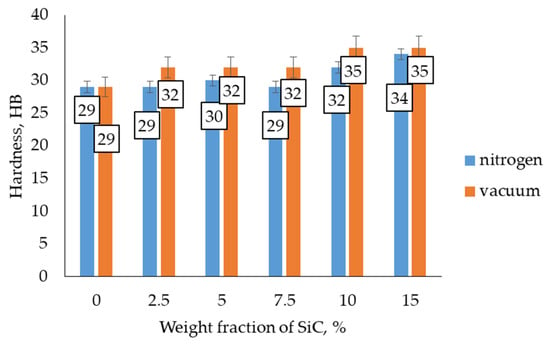
Figure 10.
Variation in Brinell hardness values of sintered aluminum matrix and Al–SiC composites, depending on the weight fraction of the reinforcement and the sintering atmosphere.
3.3.2. Flexural Strengths
The strength of the metal–ceramic interface in the Al–SiC composites was assessed through a three-point flexural test, and the results are illustrated in Figure 11. The flexural strength values are presented in relation to the sintering atmosphere and the content of the SiC reinforcement phase. Irrespective of the sintering atmosphere and the weight fraction of the reinforcement phase, the matrix of the materials without the addition of the reinforcement exhibited the highest flexural strength (253 MPa) compared with that of the aluminum matrix sintered under vacuum (208 MPa). The flexural strength values of the composites sintered in nitrogen or under vacuum were comparable, regardless of the SiC phase amount. A noticeable decline in the flexural strength occurred after exceeding 10 wt.% SiC. Notably, the nitrogen-sintered composites exhibited higher flexural strengths, indicating greater plasticity. This could be influenced by the formation of aluminum nitrides, filling the pores after sintering in a nitrogen atmosphere. The morphology of the ceramic particles, with their irregular shape, might contribute to the reduction in the flexural strength of the composites as the SiC content increases. The sharp edges of the SiC particles could promote cracks during flexural tests.
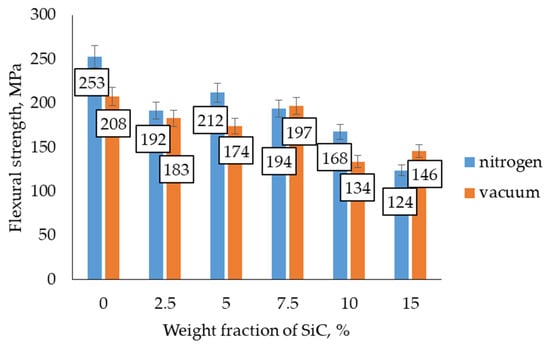
Figure 11.
Variation in flexural strengths of sintered aluminum matrix and Al–SiC composites, depending on the weight fraction of the reinforcement and the sintering atmosphere.
The fracture surfaces of the Al matrix and Al–SiC composites, as obtained after the three-point flexural tests, were observed (Figure 12 and Figure 13, respectively). The fractures on the surfaces of the Al matrixes sintered in a nitrogen atmosphere and a vacuum atmosphere exhibit a transcrystalline ductile characteristic. Visible serpentine glides (traces of the deformation slip) and dimples formed from plastic deformation within the plastic matrix are apparent (Figure 12). The ductile nature of the fracture within the matrix region is further affirmed by the presence of the flow lines in the aluminum. In the case of the Al matrix sintered in a vacuum atmosphere, the local fracture surfaces suggest insufficient connection between the particles, making them prone to tearing apart under the influence of bending forces. The fracture surfaces of the composite materials with the addition of SiC exhibit a mixed ductile–brittle characteristic (Figure 13). Ductile characteristics prevail within the matrix region, while a brittle characteristic is evident in areas where reinforcement particles are present. Debonding and fracture propagation occur along the Al/SiC interface. Locally, the SiC particles are covered by the matrix material, indicating a robust mechanical bond at the matrix/reinforcement interface.
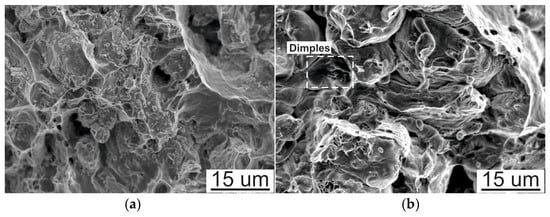
Figure 12.
SEM fracture surfaces of aluminum matrix sintered (a) in nitrogen atmosphere; (b) under vacuum.
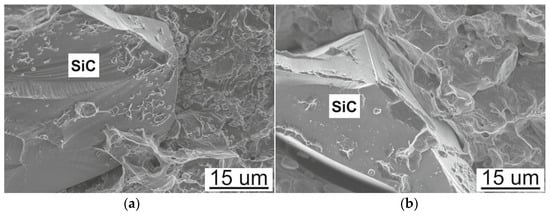
Figure 13.
SEM fracture surfaces of aluminum matrix composite with the addition of 2.5 wt.% SiC and sintered (a) in nitrogen atmosphere; (b) under vacuum.
3.3.3. Compression Strengths
The assessment of the material properties, based on the results of the static compression tests, involved analyzing compression curves in the real stress–real strain system, as depicted in Figure 14. The compressive stress at a strain of 0.2 for the Al matrix, after sintering in a nitrogen atmosphere, reached 301 MPa. In comparison, the value for the matrix sintered under vacuum was 280 MPa. For the composites sintered in a nitrogen atmosphere and under vacuum, there was a decrease in the compressive strength compared with that of the matrix without the addition of the reinforcement. The introduction of the hard SiC particles to the Al matrix resulted in an average decrease in the compressive stress at a strain value of 0.2 by 72 MPa for the nitrogen-sintered composites. Despite lower compressive stress values of the vacuum-sintered composites, averaging 207 MPa, the increase in the weight fraction of the SiC did not cause a further decrease in the stress. The stress levels remained relatively stable regardless of the amount of SiC particles. The composites sintered in a vacuum atmosphere exhibited lower plasticity and greater brittleness compared with those sintered in a nitrogen atmosphere. The deterioration in the mechanical properties attributed to the introduction of SiC-phase particles may be linked to the concentration of internal stresses and the initiation and subsequent propagation of cracks along the sharp edges of the SiC particles.

Figure 14.
Compression curves and table containing summary of stress values for Al–SiC composites sintered (a) in nitrogen atmosphere; (b) under vacuum.
3.3.4. Tribological Properties
Figure 15 and Figure 16 show graphs illustrating the average coefficients of friction and weight losses, respectively, as determined during the tribological tests, depending on the content of the SiC phase and the sintering atmosphere.
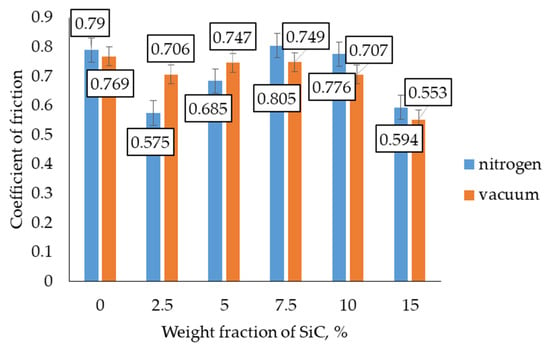
Figure 15.
Variation in coefficients of friction for sintered aluminum matrix and Al–SiC composites, depending on the weight fraction of the reinforcement and the sintering atmosphere.
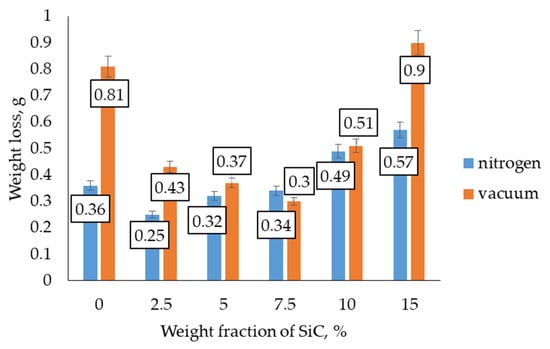
Figure 16.
Variation in weight losses of sintered aluminum matrix and Al–SiC composites, depending on the weight fraction of the reinforcement and the sintering atmosphere.
The coefficients of friction for the aluminum matrix oscillate between similar values regardless of the sintering atmosphere and are 0.79 for the matrix sintered in a nitrogen atmosphere and 0.769 for the matrix sintered under vacuum. The influence of the sintering atmosphere on the coefficients of friction is evident for the composites with the addition of the SiC particles. For lower contents of the reinforcement phase (2.5 and 5% by weight of SiC), sintering in a nitrogen atmosphere reduced the coefficients of friction compared with those of the materials sintered under vacuum. However, for higher reinforcement contents (above 7.5 wt.% SiC), the opposite trend emerged, with sintering under vacuum resulting in lower coefficients of friction. The vacuum-sintered composites, according to their reinforcement contents, exhibited coefficient of friction values at a similar level, ranging from 0.706 to 0.749, except for the composite reinforced with 15% by weight of SiC, for which the lowest coefficient of friction (0.553) was recorded. In the case of the composites sintered in a nitrogen atmosphere, the coefficients of friction initially increased with increasing SiC content, reaching a peak at 0.805 for 7.5 wt.% SiC, after which they decreased to 0.553 for the composite with 15 wt.% SiC. All the composites, except for the composite with 7.5 wt.% SiC and sintered under vacuum, exhibited lower coefficients of friction than those of the aluminum matrix. The addition of a hard SiC phase has a positive effect on the tribological properties, contributing to a longer service life for elements made of composites based on aluminum and its alloys and reinforced with silicon carbide. However, it does not significantly affect the coefficients of friction. The SiC phase will, in turn, influence the shift in the wear mechanisms. Elevated values of the coefficient of friction indicate the occurrence of intricate friction mechanisms, encompassing adhesion and cracking, during tribological contact.
Upon analyzing the impact of the sintering atmosphere on the weight loss of the produced composites, it was noted that the composites sintered in a nitrogen atmosphere exhibit a smaller weight loss compared to those sintered in a vacuum atmosphere. However, as the reinforcement content increases, these differences diminish. In the composites sintered in a nitrogen atmosphere, the positive effect of adding SiC particles is not as pronounced as in the composite materials sintered under vacuum. Conversely, for the Al–SiC composites sintered in a vacuum atmosphere, the average weight loss values for the aluminum matrix without the addition of the reinforcement are higher than those for the composites with the addition of the SiC particles, with the exception being the composite with a 15 wt.% addition of SiC. For the composites sintered in a nitrogen atmosphere, lower weight losses relative to those of the matrix material were observed only for the composites with up to 7.5 wt.% SiC. This phenomenon may be attributed to reinforcement particles detaching from the aluminum matrix during the friction process. As a result of abrasion, some hard SiC particles disintegrate into smaller particles evenly distributed in the matrix and acting as an abrasive medium. During friction, the soft matrix is first removed from the sample, leaving a layer of fine and hard SiC particles on the damaged surface. These exposed silicon carbide particles protect the soft aluminum matrix from further abrasion.
To identify the wear mechanisms of the tested composites during tribological contact under technically dry friction conditions, the worn surfaces were observed. The analysis of the Al matrix’s worn surface demonstrates that the primary wear mechanism involved during sintering in both a nitrogen atmosphere and a vacuum atmosphere is abrasive wear. This is chiefly manifested through the micro-cutting, scratching, and tearing out of material segments owing to adhesion (Figure 17). The worn surfaces exhibit distinctive longitudinal grooves aligned with the friction direction as a result of material plastic deformation. Additionally, the presence of transverse micro-cracks and localized plastic flow indicates stress fatigue in the tested materials, arising from the fatigue of the surface layer. The combination of deformations in the surface layer leads to the formation of fatigue micro- and macro-cracks, ultimately resulting in the detachment of pieces from the metal core. For the composites with the added SiC particles, the primary mechanism, alongside fatigue wear, is abrasive wear (Figure 18). Dimples in the plastic matrix are observed owing to the movement of the hard SiC particles on the soft aluminum matrix’s surface. The removal of the hard particles from the reinforcement phase, moving between the friction surface and the counter sample, induces surface scratches. Chipped particles interacting with the friction surfaces intensify the abrasive wear in the tested composites. Furthermore, there is an undesirable displacement and attachment of material parts, characteristic of adhesive wear. In the composites with the silicon carbide addition, there is an accumulation of wear products in the surface layer, reinforcing the material’s surface. In practical terms, a singular type of wear is not exclusive. Although one type of wear may dominate and dictate the degradation type and extent, other types occur to varying degrees. Observations of worn surfaces indicate the absence of a single dominant tribological wear mechanism; in addition to fatigue wear, abrasive wear is also prevalent.
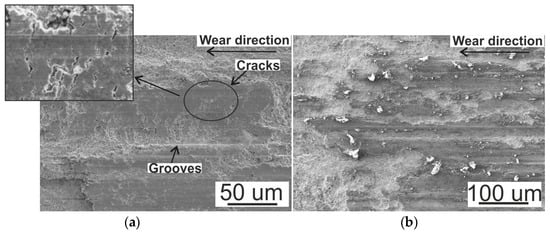
Figure 17.
SEM images of worn surfaces of aluminum matrix sintered (a) in nitrogen atmosphere; (b) under vacuum.
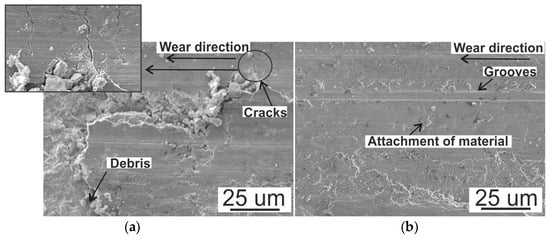
Figure 18.
SEM images of worn surfaces of aluminum matrix composite with the addition of 7.5 wt.% SiC and sintered (a) in nitrogen atmosphere; (b) under vacuum.
4. Discussion
The final properties of composites are influenced by a number of factors, including the type of matrix and reinforcements, the weight fraction of the individual composite components, the geometry of the reinforcement, the arrangement of reinforcement particles in the matrix, and their orientation and size. It should be remembered that in the process for producing materials, one of the main aspects taken into account is the technological cost for manufacturing the product. In addition to cheap solutions, there is a constant search for those that have a neutral impact on the natural environment. As a part of the research, an attempt was made to reduce the production costs of the Al–SiC composites by employing the conventional powder metallurgy method. This method not only minimizes material losses but also is an energy-efficient process with a controllable technology. By carefully selecting the technological parameters, adjusting the chemical composition of the sintering atmosphere, and managing the reinforcement particle content, it is possible to successfully achieve composites with low porosity, commendable mechanical properties, and heightened resistance to abrasive wear. Powder metallurgy technology makes it possible to produce metallic composites without significant limitations on the weight fraction of the reinforcement phase. Utilizing powder metallurgy methods in the production process for aluminum-based composites yields various economic benefits, primarily due to the relatively low temperature range required in the sintering process.
Aluminum powder is also characterized by excellent compressibility; therefore, it does not require the use of high pressing pressures in the consolidation process. It should be noted that the use of conventional methods for producing these materials from metal powders does not allow 100% densification to be obtained. Uniaxial pressing, a key process in sintered composite production with aluminum and its alloys, becomes more efficient owing to the low pressing pressures required for the aluminum powder, leading to significantly reduced tool wear [46]. Traditional powder formation methods face limitations due to friction forces between the powder particles and the die. Pressure losses derived from friction resistance result in an uneven density distribution in the green body, especially moving away from the surface of the pressing punch [48]. Powder metallurgy often involves consolidating mixtures of two or more components, with alloy powders posing greater consolidation challenges compared to pure metal powders. The introduction of a reinforcement phase, such as ceramic particles, to the aluminum matrix increases the difficulty in achieving high densification levels. The aluminum matrix in the composite exhibits the highest degree of density, with the obtained composite materials showcasing a high degree of compaction and a porosity not exceeding 7%. The densification of the composite matrix is primarily facilitated by plastic deformation and diffusion through grain boundaries. However, the addition of a reinforcement phase, like SiC particles, hampers diffusion along the grain boundaries owing to “grain boundary pinning”, resulting in increased resistance to densification [45]. The method that ensures a high product densification by reducing the friction between the powders and the die is isostatic powder densification. In the isostatic pressing method, the effective pressure acts on the entire outer surface of the consolidated powder. Hot isostatic pressing allows for the complete elimination of porosity, achieving a material density of up to 100%. It is essential to note that although it is effective, this method is one of the more expensive forming techniques [49].
The composites sintered in a vacuum atmosphere exhibited a lower degree of densification compared with those sintered in a nitrogen atmosphere. The sintering process plays a crucial role in shaping the final properties of Al–SiC composites produced through powder metallurgy methods. When aluminum powder undergoes sintering, the inevitable formation of a thin layer of aluminum oxide on its surface occurs, hindering the process owing to the higher sintering temperatures of aluminum oxide compared with that of pure aluminum. Disrupting the transparent aluminum oxide layer is essential for successful sintering. Various mechanisms, driven by the difference between the thermal expansion coefficients of aluminum and aluminum oxide, as well as the formation of a liquid phase during sintering contribute to this disruption. The reaction between Al2O3 and the sintering atmosphere further aids in the effective sintering of the aluminum powder in the solid state. Nitrogen, providing a stable and inert atmosphere, proves excellent for maintaining the composite’s integrity during sintering. Sintering in a nitrogen atmosphere is particularly effective, as it can lead to the formation of aluminum nitride, accelerating the diffusion between particles and increasing the material densification.
The aluminum nitrides that formed after sintering in a nitrogen atmosphere fill the pores, enhancing the material densification and positively impacting the final properties. In contrast, the composites sintered under vacuum exhibit lower plasticity and greater brittleness than those sintered in a nitrogen atmosphere. Fine pores are evident at the metal–ceramic interface of the vacuum-sintered composites, weakening the bond and acting as stress concentrators that could lead to fractures or other mechanical failures. Microporosity weakens the bond between the metal and ceramics, functioning as a stress concentrator that could result in fractures, cracks, or other mechanical failures. The findings indicate that microporosity at the aluminum–SiC interface influences the mechanical properties of the vacuum-sintered composites, manifesting as lower resistances to bending and compression compared with those of the nitrogen-sintered composites. Typically, the incorporation of SiC particles into the aluminum matrix enhances the overall mechanical properties [50,51]. However, the experimental results indicate that the addition of SiC particles led to a reduction in the compressive and flexural strengths of the materials when compared with those of the pure matrix. This phenomenon can be attributed to the morphology of the silicon carbide powder, characterized by its irregular shape. The edges of the particles exhibit notches, serving as potential initiation points for crack propagation during the bending and compression tests. This relationship may also arise from the concentration of internal stresses owing to the larger interaction area between the matrix and the substantial reinforcing particles. Moreover, large reinforcement particles with intrinsic defects on their surfaces, such as cracks and indentations, impact the particle fracture toughness and fail to act as an effective barrier to the externally applied load. As a result, there is a deterioration in the mechanical properties. The decline in the flexural strength with increasing SiC phase content in the composites can be ascribed to the growing prevalence of brittle particles within the matrix, thereby increasing the number of areas of stress concentration. A reduction in the flexural strength, particularly noticeable beyond 5 wt.% SiC and intensifying with higher reinforcement contents, was documented by [52]. The authors attribute this trend to the uneven distribution of the strengthening phase in the matrix. Although the current research, with its low matrix-to-reinforcement particle size ratio, successfully prevents the formation of SiC-phase agglomerates, it suggests that composites with a higher reinforcement phase content might benefit from adjustments in manufacturing process parameters, such as increased mixing times, to ensure a more uniform distribution of particles in the matrix.
The efficacy of solid-state production processes constrains the reactions between the aluminum matrix and silicon carbide reinforcement, resulting in the formation of a brittle Al4C3 compound and free silicon particles in the composites cast at the metal–ceramic interface. These compounds arise from the direct contact between the molten aluminum and SiC particles [53,54]. Microstructural observations and X-ray analyses did not indicate the presence of brittle Al4C3 phases. TEM observations revealed the presence of subgrains, with their size dependent on the sintering atmosphere. In the materials sintered in a nitrogen atmosphere, the subgrains were smaller than those in the materials sintered in a vacuum atmosphere, possibly owing to the formation of aluminum nitrides during sintering. The microstructures of the tested materials unveiled the presence of aluminum oxide primarily located at grain boundaries, adopting a characteristic chain configuration. This configuration resulted from the allotropic transformation from amorphous Al2O3 to crystalline γ-Al2O3. The differences in the density between these two varieties led to the breakdown of the thin layers of aluminum oxide, compromising their integrity.
The most significant increase in hardness, relative to that of the matrix material, is evident at higher SiC particle contents (10 and 15% by weight). This is attributed to the higher likelihood of the indenter hitting the area of the reinforcing phase with increased reinforcement contents. The variations in the thermal expansion coefficients between the ceramic particles and the metal matrix result in an elevated dislocation density at the reinforcement–matrix interfaces, thereby enhancing the hardness. The heightened hardness of the material contributes to the material’s increased resistance to wear, a crucial criterion for practical applications. A key consideration, given its application, is the resistance to the abrasive wear of the materials. The tribological properties of the tested materials were assessed through parameters, such as the coefficient of friction, weight loss, and wear mechanisms, during tribological contact under technically dry friction conditions. Tribological wear, defined as the process of material removal from a surface, involves changes in the weight, structure, and physical properties of the contact area’s surface layers. This phenomenon not only results in the wear of elements owing to material loss during friction but also leads to energy loss, which is converted to heat. Tribological behavior is influenced by various factors, including the microstructure of the tested material, the operational load, and the friction conditions [55].
Composites from the Al–SiC group exhibit superior resistance to abrasive wear compared to unreinforced aluminum alloys [56]. Numerous authors have analyzed the impact of SiC reinforcement on the tribological properties of aluminum and its alloy composites, consistently noting an enhancement in resistance to abrasive wear with an increase in the SiC particle content [57,58]. Initially, the abrasion targets the soft plastic matrix, leaving durable ceramic particles on the damaged surface. These particles subsequently protect the matrix against further abrasion and diminish the tendency of the softening matrix to adhere to the counter surface. In the research conducted for this work, the composites sintered in a nitrogen atmosphere exhibited lower weight losses compared to the materials sintered under vacuum. With an increase in the SiC particle content, both the nitrogen- and vacuum-sintered composites exhibited higher wear resistances. However, beyond 7.5 wt.% SiC, there was an uptick in the weight loss. This heightened wear is attributed to an increase in the temperature on the sample surface, causing the material to soften and flow plastically—an observation confirmed by post-friction surface examinations.
The friction surfaces of the tested materials indicate that there is no single main operating wear mechanism and that in addition to adhesive and abrasive wear, abrasive and fatigue wear was also found. The quality of the matrix–reinforcement interface significantly influences the tribological properties of composites. In the vacuum-sintered composites, the presence of micropores at the interfacial bonding is noted. This may result in poor bonding between the matrix and reinforcement, leading to the possible extraction of SiC particles from the matrix during wearing. The pulled-out ceramic particles, traversing between the friction surfaces, contribute to further abrasion, exacerbating the wear effect. The examination of the friction surfaces of the tested materials reveals the absence of a single predominant wear mechanism. In addition to adhesive and abrasive wear, both abrasive and fatigue wear are identified. Given these findings, the appropriate selection of the type and content of the reinforcing phase, as well as its arrangement and morphology prove to be crucial in shaping the properties of composite materials.
Al–SiC composites address the increasing demand for weight reduction in components while upholding high mechanical properties. The substitution of conventional steel with Al–SiC composites achieves substantial weight reduction while preserving robust resistance to abrasive wear, not only leading to greater fuel efficiency but also enhancing the heat transfer. Consequently, these composites have a diverse range of applications in the automotive and aviation industries. They represent a pioneering material, offering a distinctive amalgamation of properties derived from the combination of metal and ceramics.
5. Conclusions
Based on the conducted research and the analysis of the results, the following conclusions were formulated:
- The application of composite production technology involving double pressing and double sintering has enabled the attainment of Al–SiC composites with a relative density of no less than 92% of the theoretical density;
- In the nitrogen-sintered composites, aluminum nitride precipitates are present in the microstructure situated along the grain boundaries, positively influencing mechanical properties. Conversely, the utilization of a vacuum atmosphere for sintering aluminum-based composites is unfavorable, leading to the formation of fine pores at the grain boundaries and the metal–ceramic interface;
- The hardness of the composites increases with a higher SiC weight fraction, and this effect is more pronounced after sintering in a vacuum atmosphere. In the composites sintered in a nitrogen atmosphere, the rise in hardness relative to that of the Al matrix is particularly noticeable for higher contents of the strengthening phase (10 and 15 wt.% SiC);
- Strengthening with a hard silicon carbide phase slightly reduces the flexural and compressive strengths of aluminum-based composites. At the same time, higher mechanical properties were observed for the composites sintered in nitrogen;
- Sintering in a nitrogen atmosphere reduces the weight loss of the composites during the tribological tests. The composites with an addition of SiC particles not exceeding 10% by weight were characterized by higher wear resistances compared with that of the unreinforced matrix.
The use of conventional powder metallurgy processes as a production technology for the manufacture of composites reduces their production costs and loss of material. In addition, sintering in a nitrogen atmosphere reduces the environmental impact of the process.
Author Contributions
Conceptualization, B.L.-M. and A.W.; methodology, B.L.-M.; formal analysis, B.L.-M. and A.W.; investigation, A.W., B.L.-M. and M.M.; writing—original draft preparation, A.W.; writing—review and editing, B.L.-M. and M.M.; visualization, A.W.; supervision, B.L.-M. and M.M. All authors have read and agreed to the published version of the manuscript.
Funding
This research received no external funding.
Informed Consent Statement
Not applicable.
Data Availability Statement
The data presented in this study are available on request from the corresponding author.
Conflicts of Interest
The authors declare no conflicts of interest.
Correction Statement
This article has been republished with a minor correction to resolve spelling and grammatical errors. This change does not affect the scientific content of the article.
References
- Joost, W.J. Reducing Vehicle Weight and Improving U.S. Energy Efficiency Using Integrated Computational Materials Engineering. JOM 2012, 64, 1032–1038. [Google Scholar] [CrossRef]
- Zhu, L.; Li, N.; Childs, P.R.N. Light-weighting in aerospace component and system design. Propuls. Power Res. 2018, 7, 103–119. [Google Scholar] [CrossRef]
- Kumar, A.; Kumar, S.; Mukhopadhyay, N.K. Introduction to magnesium alloy processing technology and development of low-cost stir casting process for magnesium alloy and its composites. J. Magnes. Alloys 2018, 6, 245–254. [Google Scholar] [CrossRef]
- Abetz, C.; Georgopanos, P.; Pistidda, C.; Klassen, T.; Abetz, V. Reactive hydride composite confined in a polymer matrix: New insights into the desorption and absorption of hydrogen in a storage material with high cycling stability. Adv. Mater. Technol. 2022, 7, 2101584. [Google Scholar] [CrossRef]
- Lunetto, V.; Galati, M.; Settineri, L.; Iuliano, L. Sustainability in the manufacturing of composite materials: A literature review and directions for future research. J. Manuf. Process. 2023, 85, 858–874. [Google Scholar] [CrossRef]
- Amirtharaj, J.; Mariappan, M. Exploring the potential uses of Aluminium Metal Matrix Composites (AMMCs) as alternatives to steel bar in Reinforced. J. Build. Eng. 2023, 80, 108085. [Google Scholar] [CrossRef]
- Kandpal, B.C.; Kumar, J.; Singh, H. Machining of Aluminium Metal Matrix Composites with Electrical Discharge Machining—A Review. Mater. Today Proc. 2015, 2, 1665–1671. [Google Scholar] [CrossRef]
- Chawla, K.K.; Chawla, N. Metal-Matrix Composites. Mater. Sci. Technol. 2004, 1, 1–25. [Google Scholar] [CrossRef]
- Seetharaman, S.; Subramanian, J.; Singh, R.A.; Wong, W.L.E.; Nai, M.L.S.; Gupta, M. Mechanical Properties of Sustainable Metal Matrix Composites: A Review on the Role of Green Reinforcements and Processing Methods. Technologies 2022, 10, 32. [Google Scholar] [CrossRef]
- Stojanovic, B.; Ivanovic, L. Application of aluminium hybrid composites in automotive industry. Teh. Vjesn. 2015, 22, 247–251. [Google Scholar] [CrossRef]
- Surappa, M.K. Aluminium matrix composites: Challenges and opportunities. Sadhana 2013, 28, 319–334. [Google Scholar] [CrossRef]
- Magibalan, S.; Senthil, K.P.; Vignesh, P.; Prabu, M.; Balan, A.V.; Shivasankaran, N. Aluminium metal matrix composites—A review. Trans. Adv. Sci. Technol. 2017, 1, 1–6. [Google Scholar]
- Cleveland, C.J.; Morris, C.G. Building Envelopergy; Elsevier: Burlington, NJ, USA, 2019. [Google Scholar]
- Singh, J. Fabrication characteristics and tribological behavior of Al/SiC/Gr hybrid aluminum matrix composites: A review. Friction 2016, 4, 191–207. [Google Scholar] [CrossRef]
- Singh, N.; Mazumder, R.; Gupta, P.; Kumar, D. Ceramic matrix composites: Processing techniques and recent advancements. J. Mater. Environ. Sci. 2017, 8, 1654–1660. [Google Scholar]
- Kumar, S.S.; Senthilkumar, T.S.; Pitchipoo, P.; Dwivedi, Y.D.; Nagaprasad, N.; Saxena, K.K.; Rathinavel, S.; Eldin, S.M.; Ramaswamy, K. Grey relational analysis and surface texture analysis of Al-based metal matrix composites. J. Mater. Res. 2023, 24, 5372–5388. [Google Scholar] [CrossRef]
- Fenghong, C.; Chang, C.; Zhenyu, W.; Muthuramalingam, T. Effects of silicon carbide and tungsten carbide in aluminium metal matrix composites. Silicon 2019, 11, 2625–2632. [Google Scholar] [CrossRef]
- Parande, G.; Manakari, V.; Gupta, M. Eco-friendly Metal Matrix Composites. Encycl. Mater. Compos. 2021, 1, 140–159. [Google Scholar] [CrossRef]
- Siedlec, R.; Strąk, C.; Zybała, R. Morfologia złączy kompozytów Al/Al2O3 zgrzewanych tarciowo ze stopem Al 44200. Przegląd Spaw. 2016, 88, 9–13. [Google Scholar] [CrossRef]
- Kumar, D.; Phanden, R.K.; Thakur, L. A review on environment friendly and lightweight Magnesium-Based metal matrix composites and alloys. Mater. Today Proc. 2021, 38, 359–364. [Google Scholar] [CrossRef]
- Wojciechowski, A.; Sobczak, J. Alternative composite material solution in the frictional connections. J. KONES Intern. Combust. Engines 2003, 10, 3–4. [Google Scholar]
- Capuzzi, S.; Timelli, G. Preparation and Melting of Scrap in Aluminum Recycling: A Review. Metals 2018, 8, 249. [Google Scholar] [CrossRef]
- Bulei, C.; Kiss, I.; Alexa, V. Development of metal matrix composites using recycled secondary raw materials from aluminium wastes. Mater. Today Proc. 2021, 45, 4143–4149. [Google Scholar] [CrossRef]
- Debnath, S.; Lancaster, L.; Lung, M.H. Utilization of agro-industrial waste in metal matrix composites: Towards sustainability. World Acad. Sci. Eng. Technol. 2013, 73, 1136–1144. Available online: http://hdl.handle.net/20.500.11937/37923 (accessed on 20 November 2023).
- Saxena, A.; Saxena, K.K.; Jain, V.K.; Rajput, S.K.; Pathak, B.N. A review of reinforcements and process parameters for powder metallurgy-processed metal matrix composites. Mater. Today Proc. 2023; in press. [Google Scholar] [CrossRef]
- Jiju, K.B.; Selvakumar, G.; Prakash, S.R. Study on preparation of Al-SiC metal matrix composites using powder metallurgy technique and its mechanical properties. Mater. Today Proc. 2020, 27, 1843–1847. [Google Scholar] [CrossRef]
- Surya, M.S.; Kumar, V.N.; Sridhar, A. To Study the Effect of Varying Sintering Temperature and Reinforcement on Physical and Mechanical Characteristics of AA6061/SiC Composites. Silicon 2023, 15, 3003–3009. [Google Scholar] [CrossRef]
- Adalarasu, S.; Lokesh, K. Modelling and evaluation of Young’s Modulus of metal matrix composites using ultrasonic techniques. Insight 2006, 48, 665–670. [Google Scholar] [CrossRef]
- Cai, Z.; Zhang, C.; Wang, R.; Peng, C.; Qiu, K.; Feng, Y. Preparation of Al–Si alloys by a rapid solidification and powder metallurgy route. Mater. Des. 2015, 87, 996–1002. [Google Scholar] [CrossRef]
- Rutecka, A.; Kursa, M.; Pietrzak, K.; Kowalczyk-Gajewska, K.; Makowska, K.; Wyszkowski, M. Damage evolution in AA2124/SiC metal matrix composites under tension with consecutive unloadings. Arch. Civ. Mech. Eng. 2020, 20, 135. [Google Scholar] [CrossRef]
- Kumar, R.; Jha, K.; Sharma, S.; Kumar, V.; Li, C.H.; Mohamed, E.; Eldin, T.; Rajkumar, S.; Królczyk, G. Effect of particle size and weight fraction of SiC on the mechanical, tribological, morphological, and structural properties of Al-5.6Zn-2.2Mg-1.3Cu composites using RSM: Fabrication, characterization, and modelling. Heliyon 2022, 8, e10602. [Google Scholar] [CrossRef]
- Shaikh, M.B.N.; Aziz, T.; Arif, S.; Ansari, A.H.; Karagiannidis, P.G.; Uddin, M. Effect of sintering techniques on microstructural, mechanical and tribological propertie s of Al-SiC composites. Surf. Interfaces 2020, 20, 100598. [Google Scholar] [CrossRef]
- Pradhan, S.; Ghosh, S.; Barman, T.K. Tribological Behavior of Al-SiC Metal Matrix Composite Under Dry, Aqueous and Alkaline Medium. Silicon 2017, 9, 923–931. [Google Scholar] [CrossRef]
- Bauri, R.; Surappa, M.K. Sliding wear behaviour of Al-Li-SiCp composites. Wear 2008, 265, 1756–1766. [Google Scholar] [CrossRef]
- Kulendran, J.; Lakshmipathy, B. Reciprocating Wear Behaviour of 7075Al/SiC and 6061Al/Al2O3 Composites: A study of Effect of Reinforcement, Stroke and Load. Tribol. Ind. 2014, 36, 117–126. [Google Scholar]
- Veereshkumar, G.B.; Rao, C.S.P.; Selvaraj, M. Studies on mechanical and dry sliding wear of Al6061-SiC composites. Compos. Part B 2012, 43, 1185–1191. [Google Scholar] [CrossRef]
- Charanjit, S.; Jagteshwar, S. Synthesis of Al-SiC composite prepared by mechanical alloying. J. Mech. Civ. Eng. 2014, 11, 12–17. [Google Scholar] [CrossRef]
- Ashwath, P.; Anthony, X.M. The effect of ball milling & reinforcement percentage on sintered samples of aluminium alloy metal matrix composites. Procedia Eng. 2014, 97, 1027–1032. [Google Scholar] [CrossRef]
- Sharma, S.; Singh, D. Study of Hardness of Al-SiC Composites Using Powder Metallurgy. Int. J. Eng. Technol. Comput. Res. 2014, 2, 27–30. [Google Scholar]
- Rahman, M.H.; Al Rashed, H.M.M. Characterization of silicon carbide reinforced aluminum matrix composites. Procedia Eng. 2014, 90, 103–109. [Google Scholar] [CrossRef]
- ASTM E9-89a; Standard Test Methods of Compression Testing of Metallic Materials at Room Temperature. ASTM International: West Conshohocken, PA, USA, 1995.
- ASTM E290-22; Standard Test Methods for Bend Testing of Material for Ductility. ASTM International: West Conshohocken, PA, USA, 2022.
- ASTM E10-18; Standard Test Method for Brinell Hardness of Metallic Materials. ASTM International: West Conshohocken, PA, USA, 2018.
- ASTM D2714-94; Standard Test Method for Calibration and Operation of the Falex Block-on-Ring Friction and Wear Testing Machine. ASTM International: West Conshohocken, PA, USA, 2019.
- Jayakumar, K.; Jose, M.; Joseph, M.A.; Kumar, R.S.; Shukla, A.K.; Samuel, M.G. Synthesis and Characterization of A356-Sicp Composite Produced through Vacuum Hot Pressing. Mater. Manuf. Process. 2013, 28, 991–998. [Google Scholar]
- Pieczonka, T. Powder Metallurgy Processing of Aluminium. Polish Metall. 2006–2010 Time Worldw. Econ. Cris. 2010, 37–57. [Google Scholar]
- Schubert, T.; Pieczonka, T.; Baunack, S.; Kieback, B. The Influence of the Atmosphere and Impurities on the Sintering Behaviour of Aluminium. In Proceedings of the Euro PM2005 Congress Technical Presentations, Prague, Czech Republic, 2–5 October 2005. [Google Scholar]
- Hangl, M.; Boerger, A.; Danzer, R. Density distribution measurements in ceramic green bodies. Prakt. Metallogr. Pract. 2000, 37, 487–500. [Google Scholar] [CrossRef]
- Angelo, P.C.; Subramanian, R. Compaction of Metal Powders. In Powder Metallurgy Science, Technology and Applications; PHI Learning Private Limited: New Delhi, India, 2009; pp. 84–117. [Google Scholar]
- Sivananthan, S.; Ravi, K.; Samuel, C.S.J. Effect of SiC particles reinforcement on mechanical properties of aluminium 6061 alloy processed using stir casting route. Mater. Today Proc. 2020, 21, 968–970. [Google Scholar] [CrossRef]
- Das, D.K.; Mishra, P.C.; Singh, S. Properties of ceramic-reinforced aluminium matrix composites—A review. Int. J. Mech. Mater. Eng. 2014, 9, 12. [Google Scholar] [CrossRef]
- Kamaraj, M.; Santhanakrishnan, R.; Muthu, E. An experimental investigation on mechanical properties of SiC particle and sisal fibre reinforced epoxy matrix composites. IOP Conf. Ser. Mater. Sci. Eng. 2018, 402, 012094. [Google Scholar] [CrossRef]
- Urena, A.; Martınez, E.; Rodrigo, P.; Gil, L. Oxidation treatments for SiC particles used as reinforcement in aluminium matrix composites. Compos. Sci. Technol. 2004, 64, 1843–1854. [Google Scholar] [CrossRef]
- Tham, L.; Gupta, M.; Cheng, L. Effect of limited matrix–reinforcement interfacial reaction on enhancing the mechanical properties of aluminium–silicon carbide composites. Acta Mater. 2001, 49, 3243–3253. [Google Scholar] [CrossRef]
- Singh, K.K.; Singh, S.; Shrivastava, A.K. Study of Tribological Behavior of Silicon Carbide Based Aluminum Metal Matrix Composites under Dry and Lubricated Environment. Adv. Mater. Sci. Eng. 2016, 2016, 3813412. [Google Scholar] [CrossRef]
- Yan, H.; Ye, H.Y.; Chen, W. Dry friction and wear performance of co-continuous Al-23Si/SiC composites. Mater. Res. Innov. 2015, 19, 131–135. [Google Scholar] [CrossRef]
- Ghosh, S.K.; Saha, P.; Sutradhar, G. Study of Tribological Characteristics of Al-SiC Metal Matrix Composite. Int. J. Adv. Mater. Res. 2015, 1, 3–58. [Google Scholar]
- Sahin, Y.; Kilicli, V. Abrasive wear behaviour of SiCp/Al alloy composite in comparison with ausferritic ductile iron. Wear 2011, 271, 2766–2774. [Google Scholar] [CrossRef]
Disclaimer/Publisher’s Note: The statements, opinions and data contained in all publications are solely those of the individual author(s) and contributor(s) and not of MDPI and/or the editor(s). MDPI and/or the editor(s) disclaim responsibility for any injury to people or property resulting from any ideas, methods, instructions or products referred to in the content. |
© 2024 by the authors. Licensee MDPI, Basel, Switzerland. This article is an open access article distributed under the terms and conditions of the Creative Commons Attribution (CC BY) license (https://creativecommons.org/licenses/by/4.0/).